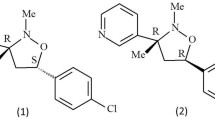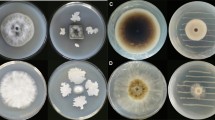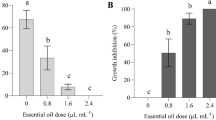Abstract
The in vitro and in vivo antifungal activity of adipic acid monoethyl ester (AAME) on the necrotrophic pathogen Botrytis cinerea has been studied. This chemical effectively controlled this important phytopathogen, inhibited spore germination and mycelium development at non-phytotoxic concentrations. The effectiveness of AAME treatment is concentration-dependent and influenced by pH. Spore germination in the presence of AAME is stopped at a very early stage, preventing germ tube development. In addition, cytological changes such as retraction of the conidial cytoplasm in the fungus are observed. AAME was also found to act on membrane integrity, affecting permeability without exhibiting lytic activity, as described previously for other antifungal compounds. Polyamine content in the mycelium of B. cinerea was also affected in response to AAME treatment, resulting in putrescine reduction and spermine accumulation similar to a number of antifungal agents. Microscopic observation of treated conidia after inoculation on tomato leaves suggested that inhibited spores are not able to attach to and penetrate the leaf. Finally, AAME completely suppressed the grey mould disease of tomato fruits under controlled inoculation conditions, providing evidence for its efficacy in a biological context and for the potential use of this chemical as an alternative fungicide treatment.









Similar content being viewed by others
References
Adrian M, Jeandet P, Veneau J, Weston LA, Bessis R (1997) Biological activity of resveratrol, a stilbenic compound from grapevines, against Botrytis cinerea, the causal agent for gray mold. J Chem Ecol 23:1689–1702
Baird-Parker AC (1980) Organic acids. In: Elliot RP, Baird-Parker AC, Bryan FL, Christian JHB, Clark DS, Olson JCB (eds) Microbiol ecology of foods, vol 1: Factors affecting life and death of microorganisms. International Commission on Microbiological Specifications for Foods, Academic Press, New York, pp 126–135
Bracey D, Holyoak CD, Coote PJ (1998) Comparison of the inhibitory effect of sorbic acid and amphotericin B on Saccharomyces cerevisiae: is growth inhibition dependent on reduced intracellular pH?. J Appl Microbiol 85(6):1056–1066
Buchenauer H (1987) Mechanism of action of triazolyl fungicides and related compounds. In: Lyr H (ed) Modern selective fungicides: properties, applications, mechanisms of action. Longman Scientific and Technical, Harlow, pp 205–231
Carbonell J, Navarro JL (1989) Correlation of spermine levels with ovary senescence and with fruit set and development in Pisum sativum L. Planta 178:482–487
Coghlan SE, Walters DR (1990) Polyamine metabolism in ‘green-islands’ on powdery mildew infected barley leaves: possible interactions with senescence. New Phytol 116:417–424
Corsetti A, Gobbetti M, Rossi J, Damiani P (1998) Antimould activity of sordough lactic acid bacteria: identification of a mixture of organic acids produced by Lactobacillus sanfrancisco CB1. Appl Microbiol Biotechnol 50:253–256
Cotoras M, Folch C, Mendoza L (2004) Characterization of the antifungal activity on Botrytis cinerea of the natural diterpenoids kaurenoic acid and 3‚-Hydroxy-kaurenoic acid. J Agric Food Chem 52:2821–2826
Dhingra O, Sinclair JB (1995) Basic plant pathology methods 2nd edn. Lewis, London
Doss RP, Potter SW, Soeldner AH, Christian JK, Fukunaga LE (1995) Adhesion of germlings of Botrytis cinerea. Appl Environ Microbiol 61:260–265
Eklund T (1989) Organic acids and esters. In: Gould CW (ed) Mechanism of action of food preservation procedures. Elsevier Applied Science, London, pp 161–184
Elad Y, Evenses K (1995) Physiological aspects of resistance to Botrytis cinerea. Phytopathol 85:637–643
Faretra F, Pollastro S (1991) Genetic bases of resistance to benzimidazole and dicarboximide fungicides in Botryotinia.fuckeliana (Botrytis cinerea). Mycol Res 8:943–951
Flors V, Miralles MC, González-Bosch C, Carda M, García-Agustín P (2003) Induction of protection against the necrotrophic pathogens Phytophthora citrophthora and Alternaria solani in Lycopersicon esculentum Mill by a novel synthetic glycoside combined with amines. Planta 216:929–938
Flors V, Miralles MC, Varas E, Company P, González-Bosch C, García-Agustín P (2004) Effect of analogues of plant growth regulators on in vitro growth of eukaryotic plant pathogens. Plant Pathol 53:58–64
Freese E, Sheu CW, Galliers E (1973) Function of lipophilic acids as antimicrobial food additives. Nature 241:321–325
Garriz A, Dalmasso MC, Pieckenstain FL, Ruiz OA (2003) The putrescine analogue 1-aminooxy-3-aminopropane perturbs polyamine metabolism in the phytopathogenic fungus Sclerotinia sclerotiorum. Arch Microbiol 180:169–175
González-Ureña A, Orea JM, Montero C, Jiménez JB (2003) Improving postharvest resistance in fruits by external application of trans-resveratrol. J Agric Food Chem 51:82–89
Grayer R, Harbone J (1994) A survey of antifungal compounds from higher plants. Phytochemistry 37:19–42
Hanssen M (1987) E for additives. The complete E number guide. ISBN: 0722511507 Thorsons, Wellingborough
Havis ND, Walters DR (1994) Fungicidal activity of the synthetic putrescine analogue, (E)-1,4-diaminobut-2-ene, and derivatives. Pestic Sci 41:61–69
Havis ND, Walters DR, Robins DJ (1997) The fungicidal diamine (E)-(N,N,N,N-tetraethyl)-1,4-diaminobut-2-ene increases spermine concentration in the late blight fungus Phytophthora infestans. Lett Appl Microbiol 25:229–232
Holyoak CD, Bracey D, Piper PW, Kuchler K, Coote PJ (1999) The Saccharomyces cerevisiae weak acid-inducible ABC transporter Pdr12 transports fluorescein and preservative anions from the cytosol by an energy-dependent mechanism. J Bacteriol 181(15):4644–4652
Hoos G, Blaich RJ (1990) Influence of resveratrol on germination of conidia and mycelial growth of Botrytis cinerea and Phomopsis viticola. J Phytopathol 129:102–110
Jewell SN, Waldo RH, Cain C, Falkinham JO (2002) Rapid detection of lytic antimicrobial activity against yeast and filamentous fungi. J Microbiol Method 49:1 –9
Keukens EAJ, de Vrije T, van den Boom C, de Waard H, Plasman P, Thiel F, Chupin V, Jongen WMF, de Kruijff B (1995) Molecular basis of glycoalkaloid induced membrane disruption. Biochem Biophys Acta 1240:216–228
Khurana N, Saxena RK, Gupta R, Rajam MV (1996) Polyamines as modulators of microcycle conidiation in Aspergillus flavus. Microbiol 142:517–523
Kinderlerer JL, Hatton PV (1990) Fungal metabolites of sorbic acid. Food addit contam 7:657–669
Knight SC, Anthony VM, Brady AM, Greenland AJ, Heaney SP, Murray DC, Powell KA, Schulz MA, Spinks CA, Worthington PA, Youle D (1997). Rationale and perspectives in the development of fungicides. Ann Rev Phytopathol 35:349–372
Koch E, Slusarenko A (1990) Arabidopsis is susceptible to infection by a downy mildew fungus. Plant Cell 2:437–445
Lamondia JA, Douglas SM (1997) Sensitivity of Botrytis cinerea from Connecticut Greenhouses to Benzimidazole and Dicarboximide fungicides. Plant Dis 81:729–732
Leroux P (1996) Recent developments in the mode of action of fungicides. Pestic Sci 47:191–197
Mackintosh CA, Slater LA, Walters DR, Robins DJ (2001) Synthesis of six novel N,N-dialkyl derivatives of spermidine and effects on growth of the fungal plant pathogen Pyrenophora avenae. FEMS Microbiol Lett 202:221–225
Osbourn A (1996) Preformed antimicrobial compounds and plant defense against fungal attack. Plant Cell 8:1821–1831
Pearce G, Moura DS, Stratmann J, Ryan CA (2001) Production of multiple plant hormones from a single polyprotein precursor. Nature 411:817–820
Rajam MV, Galston AW (1985) The effects of some polyamine biosynthetic inhibitors on growth and morphology of phytopathogenic fungi. Plant Cell Physiol 26:683–691
Ross WF, Walters DR, Robins DJ (2004) Synthesis and antifungal activity of five classes of diamines. Pest Manag Sci 60:143–148
Ruiz-Herrera J (1994) Polyamines, DNA methylation and fungal differentiation. Crit Rev Microbiol 20:143–150
Sauter H, Ammermann E, Benoit R, Brand S, Gold RE, Grammenos W, Koehle H, Lorenz G, Mueller B, Roehl F, Schirmer U, Speakman JB, Wenderoth B, Wingert H (1995) Mitochondrial respiration as a target for antifungals: lessons from research on strobilurins. In: Dixon GK, Copping LG, Hollomon DW (eds) Antifungal agents Discovery and mode of action. Bios Scientific Publishers, Oxford, , pp 173–191
Sbaghi M, Jeandet P, Faivre B, Bessis R, Fournioux JC (1995) Development of methods using phytoalexin (resveratrol) assessment as a selection criterion to screen grapevine in vitro cultures for resistance to grey mould (Botrytis cinerea). Euphytica 86:41–47
Scaramagli S, Biondi S, Torrigiani P (1999) Methylglyoxal (bis-guanyphydrazone) inhibition of organogenesis is not due to S-adenosylmethionine decarboxylase inhibition/polyamine depletion in tobacco thin layers. Physiol Plantarum 107:353–360
Shapira R, Altman A, Henis Y, Chet I (1989) Polyamines and ornithine decarboxylase activity during growth and differentiation in Sclerotium rolfsii. J Gen Microbiol 135:1361–1367
Sherald JL, Ragsdale NN, Sisler HD (1973) Similarities between the systemic fungicides triforine and triarimol. Pestic Sci 4:719–728
Skirdal IM, Eklund T (1993) Microculture model studies on the effect of sorbic acid on Penicillium chrysogenum, Cladosporium cladosporioides and Ulocladium atrum at different pH levels. J Appl Bacteriol 74(2):191–195
Stevens L, Winther MD (1979) Spermine, spermidine and putrescine in fungal development. Adv Microb Physiol 19:63–148
Stratford M, Anslow PA (1996) Comparison of the inhibitory action on Saccharomyces cerevisiae of weak-acid preservatives, uncouplers and médium-chain fatty acids. FEM Microbiol Lett 142:53–58
Stratford M, Anslow PA (1998) Evidence that sorbic acid does not inhibit yeast as a classical weak acid preservative. Lett Appl Microbiol 27:203–206
Suzuki K, Kato T, Takahashi J, Kamoshita K (1984) Mode of action of methyl N-(3,5-dichlorophenyl)-carbamate in the benzimidazole-resistant isolate of Botrytis cinerea. J Pestic Sci 9:497–501
Tiburcio AF, Kaur-Sawhney R, Ingersoll R, Galston AW (1985) Correlation between polyamines and pyrrolidine alkaloids in developing tobacco callus. Plant Physiol 78:323–326
Torrigiani P, Rabiti AL, Bortolotti G, Betti L, Marani F, Canova A, Bagni N (1997) Polyamine synthesi s and accumulation in the hypersensitive response to TMV in Nicotiana tabacum. New Phytol 135:467–473
Verhoeff K, Liem J (1975) Toxicity of R-tomatine to Botrytis cinerea, in relation to latency. Phytopathol 82:333–338
Walters DR (1995) Inhibition of polyamine biosynthesis in fungi. Mycol Res 2:129-139
Walters DR (2003) Resistance to pathogens:possible roles for free polyamines and polyamine catabolism. New Phytol 159:109–115
Walters DR, Mackintosh CA (1997) Control of plant disease by perturbation of fungal polyamine metabolism. Physiol Plant 100:689–695
Acknowledgments
This work was supported by grants from Plan Nacional I+D (AGL2003-08481), from Plan 2004 de promoción a la investigación UJI and Conselleria de Empresa, Universidad y Ciencia, Generalitat Valenciana GRUPOS04/029. M.O.L is the recipient of long-term predoctoral fellowship from grant AGL2003-08481. G.A. was supported by a grant (CTBFIS/2005/095) Beca de Formacion del Personal Técnico de Ayuda a la Investigación de la Generalitat Valenciana. The authors are grateful to Pilar Troncho and Sergio Alamar for technical assistance. We thank Dra. Brigitte Mauch-Mani for their critical review of the manuscript.
Author information
Authors and Affiliations
Corresponding author
Rights and permissions
About this article
Cite this article
Vicedo, B., Leyva, M.d.l.O., Flors, V. et al. Control of the phytopathogen Botrytis cinerea using adipic acid monoethyl ester. Arch Microbiol 184, 316–326 (2006). https://doi.org/10.1007/s00203-005-0048-6
Received:
Revised:
Accepted:
Published:
Issue Date:
DOI: https://doi.org/10.1007/s00203-005-0048-6




